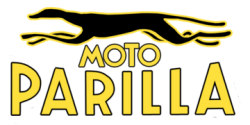

Parilla High-Cam Engines
Moto Parilla designed several different motorcycle engines over the years, but the company is most famous for the "High-Cam" motor. High-cam Parilla motorcycles are far and away the most collectable of the production Parillas imported to the United States. The high-cam engine was first put into production in 1953 as a 175cc and ended its production in the 60's upgraded to a 250cc. The left side clutch cover generally states the engine size, but there were covers with only a logo and no engine size. Here is the rundown of the various upgrades.
All motors rebuilt/restored by Fritz Duernberger of Canada.
|
|
|
|
|
|
|
This motor by is by far the most common high-cam engine Parilla produced. The GS, Speedster, and Wildcat Scrambler all started out with this engine. The motor was rated at 20hp and was able to get the bike up to 90mph. Very early motors had no clutch cover or a contoured cover. Click a picture above to see a close-up.
|
|
|
|
|
|
Cosmo offered an alloy barrel for racers from their catalog. Extremely rare, these barrels were much lighter than the standard iron barrels. The advantages of these barrels were somewhat questionable. Some say under harsh racing conditions, the barrels had a tendency to melt. Here is a GS motor with an alloy barrel that has been expanded to almost 250cc.
|
|
|
|
This engine was developed as an upgrade of the 175cc for the U.S. market. Horsepower was increased to 22hp. Some racing motors were expanded to 239cc. The clutch cover covers for most of these motors did not have the engine size cast in like the 175 & 250cc covers.
This 1960 200cc motor has a magneto ignition and a non-standard Bing carb installed. Since this is a Trailmaster motor, the oil breather and dipstick have switched places to avoid damaged to the breather.
|
|
|
|
|
Parilla's final upgrade of the 175cc engine. This motor was primarily for the U.S. market due to demand for more power. The GS, Tourist, Trailmaster, and Wildcat all had this engine in the 1960's. Some motors had the X-1 cam to get more power. Besides the obvious 250cc number cast into the clutch cover, the 250 motor had a head with extended fins around the exhaust port. Horsepower was increased to 26, making it possible to push the bike over 100mph.
|
|
|
|||
|
Twin Plug |
No Number |
|
|
S, SS, X-1, X-2 Cams: The factory made several types of cams for various models. One the low end, the unstamped cams were for touring bikes while the "S" & "SS" series were for the Sport models. The X-1 cam had a more radical shape for racing. The X-2 cam was slightly more mellow than the X-1. All cams have their ID's stamped on the part (except for early touring). |
|
|
Dipsticks & Oil breathers: Both items can be threaded into either hole in front and in behind the barrel. The shorter dipstick (14.5cm) is for the front hole and the longer 17.5 stick is for behind the barrel. Putting the wrong size stick in the wrong hole will affect the oil level and possibly the motor operation. The 125cc dipstick/oil breather is very similar to the high-cam breather, but is shorter. Some people get the two breathers confused. |
|
|
|
The original design for the engine to drive the cam was by a small chain. Parilla later offered an alternative to the chain with a gear drive. These gear drives can be found on some GS, Wildcat, and 175cc motors found in Europe. The performance difference between the two is debatable. Converting a chain drive to a gear drive is possible with a 175 with the late style chain tensioner. A 250 motor requires some modifications. |
||
|
Chain |
Gear |